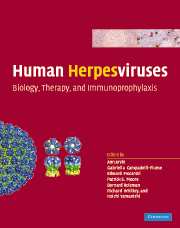Book contents
- Frontmatter
- Contents
- List of contributors
- Preface
- Part I Introduction: definition and classification of the human herpesviruses
- Part II Basic virology and viral gene effects on host cell functions: alphaherpesviruses
- Part II Basic virology and viral gene effects on host cell functions: betaherpesviruses
- Part II Basic virology and viral gene effects on host cell functions: gammaherpesviruses
- Part III Pathogenesis, clinical disease, host response, and epidemiology: HSV-1 and HSV-2
- Part III Pathogenesis, clinical disease, host response, and epidemiology: VZU
- Part III Pathogenesis, clinical disease, host response, and epidemiology: HCMV
- Part III Pathogenesis, clinical disease, host response, and epidemiology: HHV- 6A, 6B, and 7
- Part III Pathogenesis, clinical disease, host response, and epidemiology: gammaherpesviruses
- Part IV Non-human primate herpesviruses
- Part V Subversion of adaptive immunity
- Part VI Antiviral therapy
- 64 Antiviral therapy of HSV-1 and -2
- 65 Antiviral therapy of varicella-zoster virus infections
- 66 Antiviral therapy for human cytomegalovirus
- 67 New approaches to antiviral drug discovery (genomics/proteomics)
- 68 Candidate anti-herpesviral drugs; mechanisms of action and resistance
- Part VII Vaccines and immunothgerapy
- Part VIII Herpes as therapeutic agents
- Index
- Plate section
- References
68 - Candidate anti-herpesviral drugs; mechanisms of action and resistance
from Part VI - Antiviral therapy
Published online by Cambridge University Press: 24 December 2009
- Frontmatter
- Contents
- List of contributors
- Preface
- Part I Introduction: definition and classification of the human herpesviruses
- Part II Basic virology and viral gene effects on host cell functions: alphaherpesviruses
- Part II Basic virology and viral gene effects on host cell functions: betaherpesviruses
- Part II Basic virology and viral gene effects on host cell functions: gammaherpesviruses
- Part III Pathogenesis, clinical disease, host response, and epidemiology: HSV-1 and HSV-2
- Part III Pathogenesis, clinical disease, host response, and epidemiology: VZU
- Part III Pathogenesis, clinical disease, host response, and epidemiology: HCMV
- Part III Pathogenesis, clinical disease, host response, and epidemiology: HHV- 6A, 6B, and 7
- Part III Pathogenesis, clinical disease, host response, and epidemiology: gammaherpesviruses
- Part IV Non-human primate herpesviruses
- Part V Subversion of adaptive immunity
- Part VI Antiviral therapy
- 64 Antiviral therapy of HSV-1 and -2
- 65 Antiviral therapy of varicella-zoster virus infections
- 66 Antiviral therapy for human cytomegalovirus
- 67 New approaches to antiviral drug discovery (genomics/proteomics)
- 68 Candidate anti-herpesviral drugs; mechanisms of action and resistance
- Part VII Vaccines and immunothgerapy
- Part VIII Herpes as therapeutic agents
- Index
- Plate section
- References
Summary
Research into the molecular biology of herpes replication in recent years has revealed novel targets for drug development (Fig. 68.1). The characterization and functional assay of these targets have been facilitated by advancements in gene expression, protein purification, proteonomics, bioinformatics, and efficient robotic screening technologies. The pipeline for new herpes drugs has been expanding as drug candidates have evolved more rapidly due to improvements in chemical synthesis (i.e., combinatorial and parallel synthesis methods), and with aids for drug design (X-ray crystallography, in silico computer modeling tools, as well as chemoinformatics). Many new herpes inhibitors have been reported, and most of these possess novel modes of actions. Several have entered clinical evaluation, with some later discontinued because of safety issues. This chapter will describe promising drug candidates in early development that appear to act at individual steps of the viral replication cycle, and focus on those that have the most potential for success (Table 68.1).
The chemotherapy of herpes infections was markedly advanced by the discovery of the first, highly selective antiherpetic agent, acyclovir (ACV, Zovirax®; [9-(2-hydroxyethoxymethyl)guanine]) (Elion et al., 1977). Since the introduction of this agent, there has been only incremental progress in new drug approvals for the myriad of diseases caused by this family of diverse pathogens. The drugs approved since the introduction of ACV include valacyclovir (VACV, Valtrex®, the L-valine ester prodrug of ACV, penciclovir (PCV; [9-(4-hydroxy-3-hydroxymethylbutyl-1-yl) guanine]), a related nucleoside analogue with a similar basis for drug action against HSV and VZV, and its prodrug, famciclovir (FCV, Famvir®).
- Type
- Chapter
- Information
- Human HerpesvirusesBiology, Therapy, and Immunoprophylaxis, pp. 1219 - 1250Publisher: Cambridge University PressPrint publication year: 2007
References
- 3
- Cited by

